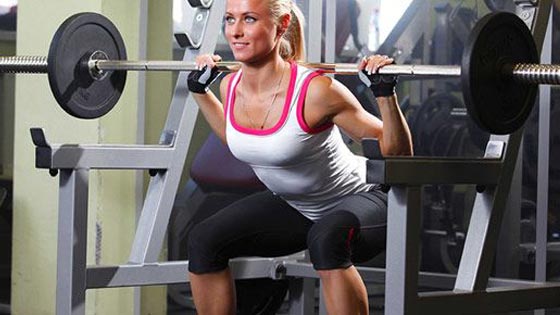Bar squat

This bodybuilding exercise uses and develops the entire body but mainly targets the thigh muscles and glutes. This is the king of bodybuilding exercises. “Those who don't squat, don't lift weights” is a phrase we often hear from bodybuilders. Quite technical, it requires good balance and a certain flexibility. Effective and profitable, it is not suitable for all body types who will benefit more from other exercises.
Targeted Muscles
The gluteus maximus, quadriceps (anterior rectus, crural biceps, vastus lateral and internal), rear thighs (semi-membranous, semi-tendinosus), soleus of the calves, the abdominal fixator muscles, gluteus minimus and medius, adductors, back (spinal , lumbar ) and to a lesser extent the muscles of the shoulder girdle (shoulders, trapezius) to hold the bar.
Execution of the exercise
Standing, the bar resting on the trapezius, hands spaced shoulder-width apart or more, feet duck - at ten o'clock - slightly wider than shoulder-width apart and placed in line with the knees. Bend your knees and push your buttocks back with your torso straight. Theoretically go down until your thighs are parallel to the floor. Limit the amplitude if you feel that you are going to round your back or if your heels come off the ground. The bar goes down and back up vertically, without stops in the high position and bounces in the low position. Balancing can be difficult at first, it takes time to master the exercise.
Breathing
Inhale as you lower the bar and exhale as you return to the starting position.
It is not advisable to block your breathing when going up. However, this maneuver helps minimize the risk of lumbar injury when the load is heavy. Blocked breathing and contracted abdominals support the trunk in the critical part of the movement and protect the spine, provided that you obviously keep your back straight.
Safety instructions
Work safely with a bar rest or a squat cage. This is used to rest the bar on the supports (stands) between sets but above all to get rid of it in case you get stuck under the load in the low position.
Beginners in strength training should learn this movement using a light barbell and increase the load once the exercise is mastered. It is better to learn it in the gym, with a state-certified professional coach.
Variants
Variations are possible by playing on the position of the feet and the spacing of the thighs.
If the thighs are very apart and the feet placed in a duck position - at ten past ten - this will cause more work for the inside of the thighs (the adductors).
If the legs are closed together with the feet straight, this puts more strain on the vastus lateralis located on the outer side of the thighs.
.png)